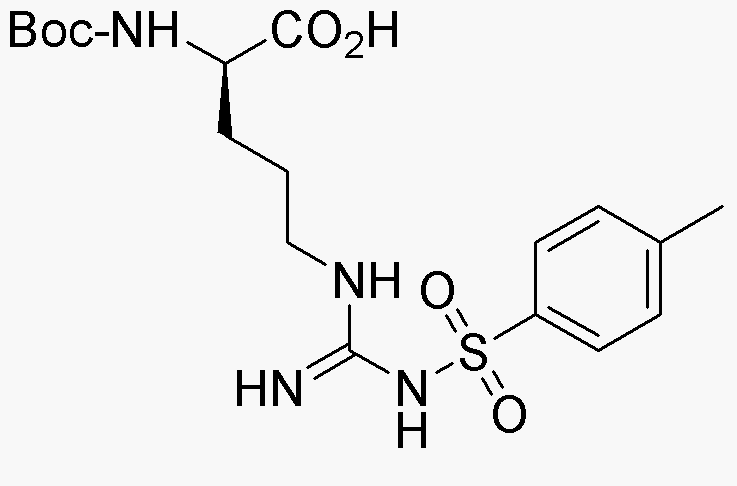Na-Boc-Nw-4-toluenesulfonyl-D-arginine is widely utilized in research focused on:
- Peptide Synthesis: This compound serves as a protecting group in the synthesis of peptides, allowing for the selective modification of amino acids without affecting others. This is crucial for researchers developing complex peptides for therapeutic applications.
- Drug Development: It plays a role in the design of novel drugs, particularly in creating inhibitors for specific enzymes. Its ability to modify arginine residues enhances the efficacy of potential drug candidates in treating various diseases.
- Bioconjugation: The chemical is used in bioconjugation techniques, linking biomolecules to drugs or imaging agents. This is beneficial in the field of targeted therapy, improving the delivery of therapeutic agents to specific cells.
- Protein Engineering: Researchers utilize this compound to introduce functional groups into proteins, enhancing their stability and activity. This is particularly valuable in the production of therapeutic proteins and enzymes.
- Diagnostics: It is also applied in the development of diagnostic tools, where its properties can help in the detection of specific biomolecules, aiding in disease diagnosis and monitoring.
General Information
Properties
Safety and Regulations
Applications
Na-Boc-Nw-4-toluenesulfonyl-D-arginine is widely utilized in research focused on:
- Peptide Synthesis: This compound serves as a protecting group in the synthesis of peptides, allowing for the selective modification of amino acids without affecting others. This is crucial for researchers developing complex peptides for therapeutic applications.
- Drug Development: It plays a role in the design of novel drugs, particularly in creating inhibitors for specific enzymes. Its ability to modify arginine residues enhances the efficacy of potential drug candidates in treating various diseases.
- Bioconjugation: The chemical is used in bioconjugation techniques, linking biomolecules to drugs or imaging agents. This is beneficial in the field of targeted therapy, improving the delivery of therapeutic agents to specific cells.
- Protein Engineering: Researchers utilize this compound to introduce functional groups into proteins, enhancing their stability and activity. This is particularly valuable in the production of therapeutic proteins and enzymes.
- Diagnostics: It is also applied in the development of diagnostic tools, where its properties can help in the detection of specific biomolecules, aiding in disease diagnosis and monitoring.
Documents
Safety Data Sheets (SDS)
The SDS provides comprehensive safety information on handling, storage, and disposal of the product.
Product Specification (PS)
The PS provides a comprehensive breakdown of the product’s properties, including chemical composition, physical state, purity, and storage requirements. It also details acceptable quality ranges and the product's intended applications.
Certificates of Analysis (COA)
Search for Certificates of Analysis (COA) by entering the products Lot Number. Lot and Batch Numbers can be found on a product’s label following the words ‘Lot’ or ‘Batch’.
*Catalog Number
*Lot Number
Certificates Of Origin (COO)
This COO confirms the country where the product was manufactured, and also details the materials and components used in it and whether it is derived from natural, synthetic, or other specific sources. This certificate may be required for customs, trade, and regulatory compliance.
*Catalog Number
*Lot Number
Safety Data Sheets (SDS)
The SDS provides comprehensive safety information on handling, storage, and disposal of the product.
DownloadProduct Specification (PS)
The PS provides a comprehensive breakdown of the product’s properties, including chemical composition, physical state, purity, and storage requirements. It also details acceptable quality ranges and the product's intended applications.
DownloadCertificates of Analysis (COA)
Search for Certificates of Analysis (COA) by entering the products Lot Number. Lot and Batch Numbers can be found on a product’s label following the words ‘Lot’ or ‘Batch’.
*Catalog Number
*Lot Number
Certificates Of Origin (COO)
This COO confirms the country where the product was manufactured, and also details the materials and components used in it and whether it is derived from natural, synthetic, or other specific sources. This certificate may be required for customs, trade, and regulatory compliance.


